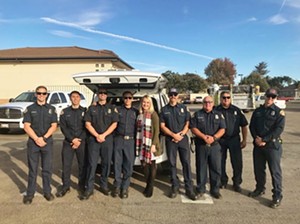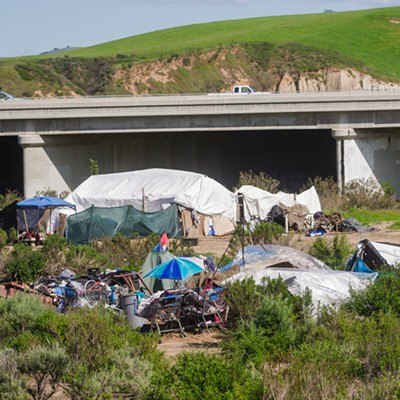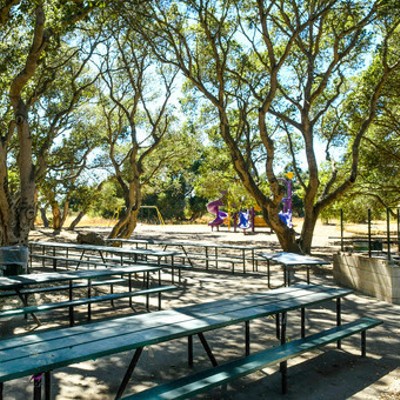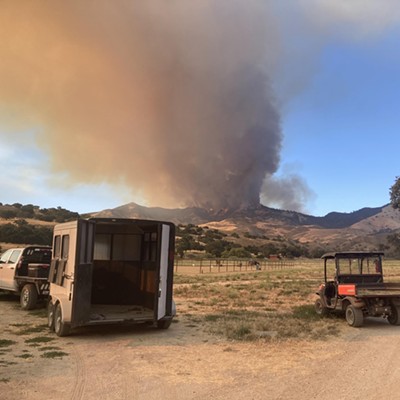Last year's holiday season was extra busy for Shannon Elliott.
As a volunteer for CALM (Child Abuse Listening Mediation), a nonprofit that serves local families with therapy regardless of financial means, Elliott was tasked with helping organize gift giving for not just her own family, but more than 100 families in Santa Maria and Lompoc through the organization's Adopt a Family program. The program allows locals to donate gifts to a specific family served by CALM, Elliott explained, based on wish lists that parents and kids fill out during therapy sessions.

"The families will turn in a wish list to the therapist, and the therapist will give it to me, and I will try and find a donor in the community that can assist them," she said. "It's basically finding donors to match with families that are receiving CALM's services and need a little extra assistance during the holidays."
CALM Development Manager Sandra Fuhring, who's tasked with organizing fundraising and volunteers for the nonprofit, said she has led the project in the past, but "it just became such a big job" as the organization has expanded its reach in North Santa Barbara County.
Thankfully, Fuhring said, Elliott joined the organization's North County Advisory Committee five years ago after she moved to town and started looking for volunteer opportunities. Now, the Adopt a Family program is Elliott's baby.
"It's a huge undertaking," Fuhring said. "It's been great to have her because I don't have to worry about it at all, and she's just on top of everything."
A Santa Barbara-based nonprofit, CALM opened its Santa Maria location in 2010 and another in Lompoc last year to help address childhood trauma in the area. That expansion means more families than ever in North County qualify for Adopt a Family.
Keeping all those wish lists, families, and donors straight is a challenge, but Elliott's prior work experience at a state agency in Utah helped her instill strong time management and organization skills, she said. Her skill set notwithstanding, Elliott also faces the added difficulty of privacy laws surrounding therapy, so she never actually meets the families being adopted.
"It's hard to keep track of families you've never met, both the donors and the recipients," she said. "You're just kind of organizing all of that and sometimes going on blind faith that this is all going to come together."
Elliott mostly reached out to donors via email, she said. Often, whole offices, sports teams, families, or groups of friends will all pitch in to buy gifts for a family.
Donors are asked to get at least one gift for each person on the list. The adopted families are asked to provide a few options for each member, so donors can choose.
"We have a lot of donors that will provide everything on the wish list and some that will provide kind of a toy and then a need, so we get a whole range of the wishes fulfilled," she said.

Many of CALM's client families are low income, Elliott explained, and while kids may ask for video games or toys, parents often have more pressing needs in mind. Some wish lists include basic necessities like dish soap, laundry detergent, or diapers.
"We've had families that didn't have beds, so we've had people who will donate brand new mattresses and bed frames," she said. "We've heard stories where all the kids were sleeping on the floor."
Many of the children who receive therapy from CALM have endured some form of traumatic abuse, and CALM's staff members employ a variety of therapeutic methods to aid in recovery and build resilience.
One such method is color therapy, where kids color, draw, or paint to express feelings and ideas. After they receive their gifts, the kids create "thank you" cards as part of their sessions.
Fuhring said that volunteers like Elliott have helped spread awareness of CALM in North County, but that they also allow CALM staff to remain focused on care first by raising money and organizing programs like Adopt a Family. And in Santa Maria and Lompoc, CALM staff have plenty of work to do, she explained,
"In Santa Barbara County every year there's an average of around 5,000 reported cases of child abuse, and 4,000 of those come from North County," she said. "So the majority are up here, and we have a lot more families living in poverty and there's more stressors for the families here. The services are necessary, so I think it's great that our volunteers are trying to get the community involved in that, to care about that, and want to support kids here."
Across her time coordinating Adopt a Family, Elliott has seen groups of staff from the Santa Maria City Attorney's Office and the Santa Maria Fire Department all pitch in to adopt several local families. She's also seen wealthy families purchase a brand new PlayStation, a single mom adopt a family of four, and someone "paying it forward" after receiving help during holidays past.
It's all a reminder of just how giving people in the area are, she said. All she has to do is reach out and ask.
"It tugs at my heartstrings a lot and makes me realize I'm really lucky for the community support we live in," she said. "And it also makes me think, if there were situations in my life that I needed a service like CALM, just to put myself in their shoes."
Managing Editor Joe Payne can be reached at [email protected].
Second chances
Santa Barbara County Animal Care Foundation founder Linda Greco is focused on helping pets in need
BY REBECCA ROSE
Take one look around boutique pet shop and spa That’s Fetch and it’s clear owner Linda Greco has an unapologetic love for animals. But the shop isn’t just a business venture for her.
Behind the walls decked out with sparkled faux-diamond dog collars and cat toys shaped like breakfast foods lies a deeper sense of purpose for Greco. It’s her way of balancing the work she does with the Santa Barbara County Animal Care Foundation, a locally based animal welfare organization she helped launch 17 years ago.
“It can be very heavy seeing all of the despair for animals,” Greco said. “Some of the cases you see can be difficult. So opening this store was me doing something daily to see people coming in who cherish their animals.”
The Animal Care Foundation’s story began in 2002, when Greco and two friends formed the charity to work alongside county animal shelters. The first project they identified was fundraising to help build a new Santa Barbara County animal shelter in Santa Maria.
“It had been on the books for ages, and each year it was getting further and further behind because costs were going up,” Greco said. “We were able to, within that first year, secure just under $1 million to then go to the county and say, ‘Here’s the money you need, can we go through with this project?’”
With the foundation’s financial assistance, the doors of the shelter opened in 2005. After that, the organization began to look at what the most pressing needs in the county were for shelter animals. Those needs were largely medical, and North County was a high priority area, Greco said, with much of the need focused in Santa Maria.
That’s where the Animal Care Foundation comes in. According to the organization’s website, its mission is “to promote animal welfare and to better the quality of life for animals in Santa Barbara County through education, outreach, collaboration, and promotion of the humane ethic and responsible treatment of all animals.” The organization raises money to pay for services for animals that might otherwise be euthanized due to medical issues.

Greco said the organization focuses specifically on raising funds to treat animals in shelters that need specialized medical care beyond what the county could typically pay for. Greco said that raising money has been challenging for the group, which holds fundraisers and applies for grants. Volunteers are currently working to raise $72,000 for the projected 2019 budget.
The money, for medical services and diagnostic testing, goes directly to the needs of the animals, Greco explained, and not to the county shelter or a general fund. The foundation also works with local veterinarians and clinics to get reduced costs for certain procedures.
“People don’t realize the number of animals that come in to the shelter that are in need of medical attention,” Greco said. “It can be that they get hurt or neglected and they come in with those issues. There’s a whole group within these county shelters that are needing medical assistance.”
It can be difficult to estimate just how many animals the group can help because the dollar amount may vary from case to case, Greco said, adding that services covered could range from a simple X-ray to an orthopedic surgery.
The group also helps with behavioral interventions, paying for trainers to work with animals and make them better candidates for adoption. Other programs under the foundation’s umbrella include Camp HOPE, a camp for children ages 9 through 12 that introduces youth to basic pet responsibly and allows them to explore career and volunteer opportunities related to animal services. The organization also puts on annual events such as the Zombie Glow Run, a charity 5K that benefits the county shelter.
Doing all of that work is a network of volunteers, including seven board members who each donate their time. Volunteers are what allow the organization to keep overhead costs down and devote more money to the animals themselves, Greco said.
“We are all volunteer,” she said. “We work from our homes … we don’t have paid staff. We don’t have a facility to maintain … our overhead is so minimal.”
Greco said the Animal Care Foundation always needs volunteers for events. The organization is seeking volunteers to help with grant writing and marketing as well, she explained, to help bring in corporate sponsorships and promote the organization in the community and beyond.
As for her personal involvement and passion for the cause, Greco said what drives her is the desire to make a difference in the lives of animals in her community, even though she knows it often takes time and patience.
“If you love animals, come on board with us,” she said. “We would love to utilize you in some way. … You can make a difference.”
Arts and Lifestyle Writer Rebecca Rose can be reached at [email protected].
Making it count
United Way in need of volunteers for 2019 countywide tally of homeless population
BY KASEY BUBNASH
When Dorothy Mogavero first signed on to help out with Santa Barbara County's Point in Time Count several years ago, she was nervous.
Despite being a seasoned volunteer who spends much of her free time helping fight homelessness and poverty, the Point in Time Count, she said, felt like uncharted territory. During the event, which is conducted every two years and mandated by the U.S. Department of Housing and Urban Development, volunteers fan out and attempt to count every unsheltered homeless person in the entire county in less than four hours.
Volunteers introduce themselves to the homeless individuals and families they meet, hand out and collect surveys for the county, and take note of where the homeless are sleeping, how long they've gone without shelter, and other information that is subsequently included in a county report on homelessnesses.
It takes hundreds of volunteers and months of planning. It forces volunteers out of their comfort zones and under the bridges, behind the strip malls, and into all the places where some people are forced to spend their nights. And in order to be successful, it requires a lot of face-to-face interaction.
That's what Mogavero worried about most: how to approach homeless individuals she'd never met before, and how to go about asking for personal information about their lives.
Fortunately, Mogavero said volunteers go through an hour-long training that teaches them just that. During the training sessions, volunteers learn about how to approach homeless individuals, how to remain nonconfrontational, and how to explain the count and why it's important.

Once Mogavero completed her training and got out in the field, she said it was exciting to meet so many people and hear their stories. She was shocked to learn that many of the people without homes have tried repeatedly to find housing, that it's often not the result of bad choices or laziness as stereotypes might suggest, and that many of the homeless individuals in the county are former foster children who aged out of the system at 18 and had nowhere to go.
She realized how important the count is, and she's done it nearly every year since.
"We're here to make sure they count in our community," Mogavero said.
Mogavero is just one of nearly 153 volunteers who have already signed up to help with this year's Point in Time Count, according to Emily Allen, director of homeless and veterans impact initiatives for United Way of Northern Santa Barbara County, an organization that works to connect those experiencing homelessness with necessary support resources. United Way also helps coordinate the Point in Time Count.
While Allen said she's grateful to each of the volunteers who have already offered up their time, the whole canvassing process usually takes about 400 volunteers to be successful. They still have quite a ways to go, and not a lot of time to gather a larger team.
This year's count is scheduled for Jan. 24, and volunteers will head out at 5 a.m. and should wrap up by about 8:30 a.m. Volunteers will be split up into teams of about four, assigned a geographical section of the county, and led through the area by a person who has experienced homelessness. Those guides, Allen said, act as liaisons between the surveyors and the homeless population.
It's a rewarding experience, Allen said, and the information gathered during the count is used by numerous organizations and the county while applying for federal and state funding, and allows lawmakers to create legislation that will better meet the needs of homeless people in the area.
"Our county depends on it," she said.
Staff Writer Kasey Bubnash can be reached at [email protected].








